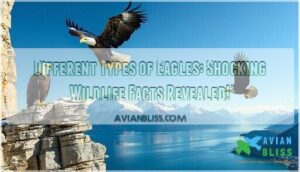This site is supported by our readers. We may earn a commission, at no cost to you, if you purchase through links.

From the massive Harpy Eagle of South America to the sleek Sea Eagle of coastal regions, these majestic hunters showcase incredible diversity.
You’ll find over 60 species spanning continents, each with unique adaptations for survival.
Whether they’re soaring over Arctic tundras or tropical rainforests, these raptors demonstrate nature’s remarkable design.
Some hunt fish, others target snakes or small mammals, but all share razor-sharp talons and incredible vision that make them apex predators.
Want to know which eagle species might surprise you with their jaw-dropping hunting skills?
Table Of Contents
- Key Takeaways
- Eagle Species Overview
- Types of Eagles
- Eagle Physical Characteristics
- Eagle Habitat and Distribution
- Eagle Behavior and Diet
- Frequently Asked Questions (FAQs)
- How many species of eagles are there?
- What are some common eagle species?
- What are the different types of sea eagles?
- Which group of eagles have feathers?
- What are the different types of hawk eagles?
- What are the different types of serpent eagles?
- Which eagle is the largest?
- What is the rarest eagle?
- Which eagle is the most powerful?
- Which eagle is most common?
- Conclusion
Key Takeaways
- You’ll discover an incredible diversity of eagle species, with over 60 unique types across 22 genera, each adapted to specialized hunting environments from Arctic tundras to tropical rainforests.
- You’ll be amazed by eagles’ extraordinary physical adaptations, including razor-sharp talons, incredible vision, and wingspans up to 8 feet that make them apex predators in their ecosystems.
- You’ll learn that eagles inhabit nearly every continent except Antarctica, showcasing remarkable adaptability by thriving in coastal regions, mountain ranges, grasslands, and dense forests.
- You’ll understand that conservation is critical, with many eagle species facing challenges from habitat loss, climate change, and human activity, making their survival dependent on protective efforts.
Eagle Species Overview
You’re about to explore the fascinating world of eagles, where 254 unique species soar across diverse ecosystems and challenge your understanding of these majestic predators.
From the iconic Bald Eagle to the rare Philippine Eagle, you’ll discover how these remarkable birds of prey represent a complex taxonomy within the Accipitridae family.
Encompassing fascinating subfamilies like snake eagles, sea eagles, and harpy eagles.
Family Accipitridae
Ever wondered what holds the eagle kingdom together? The Accipitridae family is nature’s grand design for raptors, encompassing a breathtaking array of hawks, eagles, and kites.
Nature’s raptors united: Accipitridae, the magnificent family where hawks, eagles, and kites dance through evolutionary skies.
With remarkable genetic diversity, this family represents a complex evolutionary tapestry spanning the Accipitriformes order. Scientists track its global distribution, revealing intricate conservation challenges.
From soaring Golden Eagles to stealthy predators, Accipitridae embodies nature’s most sophisticated aerial hunters, showcasing remarkable adaptation and survival strategies across diverse ecosystems.
Eagle Subfamilies
Breaking free from traditional classification, eagle subfamilies reveal nature’s incredible diversity within the Accipitridae family.
Want to know what makes these magnificent birds unique?
- Circaetinae snake-hunting specialists
- Haliaeetinae masters of aquatic prey
- Harpiinae forest dominators
From Aquilinae’s robust characteristics to Circaetinae’s specialized diet, each subfamily tells a story of evolutionary adaptation.
Golden eagles, for example, display monogamous breeding behavior.
These remarkable bird groups showcase how environmental challenges shape survival strategies across different eagle classifications.
Genera and Species Classification
When the hawk’s nest reveals a complex puzzle, eagle taxonomy emerges as nature’s intricate sorting system.
With over 60 eagle species across 23 genera, scientists map genetic relationships and subspecies variations.
Genera like Aquila and Haliaeetus showcase remarkable diversity, illuminating critical conservation implications.
Taxonomic revisions challenge traditional classifications, revealing how eagles adapt and survive through fascinating hybridization events that reshape our understanding of these magnificent aerial predators.
Types of Eagles
You’ll be amazed by the incredible diversity of eagles, ranging from massive sea eagles with wingspans over 8 feet to tiny booted eagles barely 18 inches long.
Each eagle type—whether serpent-hunting snake eagles, fish-snatching sea eagles, tree-dwelling booted eagles, or powerful harpy eagles—represents a fascinating adaptation to unique ecological niches across the globe.
Sea Eagles
Sea eagles reign supreme in coastal and marine territories, each species uniquely adapted to their watery domains. Their mastery spans global ecosystems through incredible Stellers adaptations and Haliaeetus conservation efforts.
- Coastal hunters with razor-sharp fishing skills
- Masters of marine food chains
- Incredible wingspan reaching over 2 meters
- Diverse plumage variation across species
From Russia’s icy rivers to Australia’s remote shorelines, these magnificent fish eagles showcase nature’s remarkable engineering, turning oceanic hunting into an art form of survival and precision.
Snake Eagles
Shifting from coastal hunters, snake eagles from the Circaetinae genera master desert survival with extraordinary venom resistance.
These Circaetus and Spilornis birds of prey specialize in reptilian diets, targeting snakes and lizards with precision hunting techniques.
Brown Snake Eagles and Short-toed Snake Eagles prowl open plains, showcasing remarkable adaptability.
The Philadelphia Eagles, however, showcase different types of eagles altogether.
Their conservation status remains vulnerable, highlighting the urgent need to protect these remarkable predators and their unique habitats.
Booted Eagles
While snake eagles slither through serpentine territories, booted eagles soar through forest landscapes with unmatched grace.
These remarkable Aquila and Hieraaetus species showcase extraordinary adaptations that set them apart in the raptor world. Their distinctive feathered legs mark their unique identity, enabling precise hunting strategies across diverse ecosystems.
- Masters of aerial navigation
- Resilient forest predators
- Dynamic hunting specialists
- Symbols of ecological balance
Human adaptability meets nature’s design in these magnificent true eagles, showcasing extraordinary adaptations and unique identity as magnificent true eagles.
Harpy Eagles
Nature’s forest phantoms, harpy eagles are apex predators that inspire awe with their extraordinary capabilities.
Harpy eagles: Phantoms of the rainforest, masters of survival with talons that carve legends into the canopy.
These remarkable birds dominate tropical rainforests from Mexico to Argentina, wielding powerful hunting skills that make them legendary.
| Feature | Description | Conservation Status |
|---|---|---|
| Size | 13-20 lbs | Vulnerable |
| Wingspan | Up to 6.5 feet | Declining Population |
| Habitat | Tropical Rainforests | Threatened |
| Unique Trait | Bear-like Talons | Critical Ecosystem Role |
With razor-sharp talons comparable to grizzly bear claws, harpy eagles maneuver through dense canopies, targeting sloths and monkeys.
Their survival hinges on critical habitat preservation, making harpy conservation a pressing mission for protecting these magnificent birds of prey.
Eagle Physical Characteristics
You’ll be amazed by eagles’ extraordinary physical features, from their massive wingspans to razor-sharp talons that make them nature’s ultimate aerial predators.
Each eagle species boasts unique characteristics like distinctive plumage colors, eye shapes, and body sizes that help them survive in diverse habitats across the globe, with razor-sharp talons being a key adaptation.
Size and Weight
In the context of eagles, size isn’t just a number—it’s a survival strategy. Weight Variation plays a massive role in these predators’ lives.
From the compact 10-pound Golden Eagle to the muscular 20-pound Harpy, each bird’s Body Mass tells a unique story of adaptation and power.
- Size determines hunting capabilities
- Weight influences aerial maneuverability
- Body mass impacts prey selection
- Growth Stages reveal evolutionary design
Wingspan and Color
After comparing your body size to an eagle’s wingspan, you’ll be amazed.
Eagles showcase remarkable plumage variation across their species, with wingspans stretching up to seven feet.
The Golden Eagle’s rich brown and gold feathers contrast sharply with the Bald Eagle’s stark white head and tail.
Color camouflage plays a critical role in survival, with juvenile eagles sporting different hues than adults.
Regional differences in wingspan and plumage help these majestic birds adapt to diverse environments, making each eagle species a unique marvel of nature’s design.
Eye Color and Shape
Ever wondered how eagles spot a tiny mouse from sky-high altitudes?
Their eye morphology is a masterpiece of diurnal vision—sharp, piercing orbs ranging from golden amber to rich brown.
These precision instruments boast round pupils and razor-sharp iris structures, engineered for unparalleled visual acuity.
Each eagle species rocks unique eye characteristics, making their vision a breathtaking adaptation that transforms hunting from a challenge into an art form.
Beak and Talon Structure
After scanning those piercing eagle eyes, your gaze drops to their arsenal of survival: razor-sharp talons and curved beaks.
Eagles possess extraordinary bone density and grip strength, crafted through millions of years of evolutionary adaptations.
Their hooked beaks slice through prey with surgical precision, while razor-like talons lock onto targets with unbreakable resolve.
Whether hunting small mammals or fish, these birds of prey showcase nature’s most sophisticated hunting weaponry – transforming each encounter into a masterclass of survival strategy and predatory excellence.
Their talons are essential for hunting, and grip strength is notable among raptors.
Eagle Habitat and Distribution
You’ll be amazed by the incredible adaptability of eagles, which have successfully colonized diverse ecosystems from freezing Arctic tundras to tropical rainforests across every continent except Antarctica.
Their remarkable range spans continents, with different species strategically inhabiting environments like coastal regions, mountain ranges, grasslands, and dense forests, demonstrating nature’s incredible evolutionary resilience, showing incredible adaptability and evolutionary resilience.
Geographic Range
How vast is the domain of eagles? These magnificent birds command an impressive global distribution, stretching across continents and surviving challenging landscapes.
Their remarkable adaptability reveals nature’s resilience.
- North American eagles roam from Alaska to Mexico
- African species dominate sub-Saharan regions
- Eurasian eagles populate diverse ecosystems
Habitat loss and climate change increasingly challenge their survival, pushing conservation efforts to protect these incredible predators.
Regional variations in distribution showcase eagles’ incredible capacity to thrive in dramatically different environments, highlighting their remarkable adaptability and impressive global distribution.
Preferred Habitats
Nearly every eagle species carves out its niche in wildly different landscapes.
From dense forest ecosystems to windswept mountain ranges, Mountain Eagles and Forest Eagles adapt remarkably well.
Coastal Eagles thrive near ocean cliffs, while Grassland Eagles hunt expansive plains.
Urban Eagles even find sanctuary in surprising city spaces.
Eagle habitat types vary greatly depending on the species.
These remarkable birds showcase incredible flexibility, transforming challenging terrains into perfect hunting grounds with their unparalleled survival instincts.
Sensitivity to Human Activity
When human activities bulldoze through eagle territories, these majestic birds face serious challenges.
Habitat fragmentation and urban expansion disrupt critical nesting sites, forcing eagles to abandon vulnerable eggs. Noise pollution and hunting impacts further stress their delicate ecosystems.
Conservation efforts through IUCN initiatives are essential for protecting these endangered species and preserving their rapidly shrinking habitats.
Harpy eagles, for example, exhibit territorial behavior guarding large areas, showcasing their need for habitat preservation and conservation efforts.
Migration Patterns
Through the skies, eagles set out on epic migrations that reveal incredible survival strategies.
Their journeys showcase remarkable navigation techniques across diverse landscapes:
- Bald eagles track ice-free water corridors
- Golden eagles follow prey migration routes
- Wind currents sculpt their aerial pathways
- Juvenile eagles pioneer northern exploration
- Conservation efforts protect critical migration corridors
These seasonal movements highlight the resilience of bird species traversing complex environmental challenges, demonstrating their ability to adapt to diverse landscapes and complex environmental challenges.
Conservation efforts are crucial for the protection of these species, and understanding their migration corridors is key to this endeavor.
Eagle Behavior and Diet
You’ll be amazed by the incredible hunting prowess and diverse diets of eagles, nature’s most formidable aerial predators.
From soaring high above landscapes to executing precision strikes, these magnificent birds showcase remarkable skills that’ll make you appreciate their role in maintaining ecological balance, highlighting their remarkable skills.
Prey and Hunting Skills
Imagine eagles as nature’s precision hunters, orchestrating aerial pursuits that’ll leave you breathless.
Their razor-sharp vision transforms the landscape into a tactical hunting ground, where talon strength meets unparalleled prey capture strategy.
Eagles often hunt a variety of animals, and understanding preferred meals can reveal insights into their hunting territories.
Witness their hunting mastery—a symphony of power and survival.
Scavenging and Carrion Eating
Eagles aren’t just fierce hunters—they’re opportunistic survivors who embrace nature’s buffet of carrion.
Their razor-sharp survival instincts kick into high gear when scanning landscapes for leftover meals.
These raptors leverage scavenging as a smart energy-conservation strategy:
- Maximize nutritional intake
- Reduce hunting expenditure
- Control potential disease spread
- Compete across ecological niches
- Optimize survival chances
Their keen decay detection transforms seemingly worthless remains into life-sustaining resources, proving that adaptability trumps specialization in the wild.
Flight Abilities and Speed
After scavenging for prey, eagles exhibit breathtaking flight abilities that defy gravity.
Their soaring techniques and wing loading transform them into aerial predators, reaching dive speeds up to 200 mph.
Different species master unique flight adaptations, traversing migration altitudes with precision.
These birds of prey command the sky, their wingspan and speed telling a story of evolutionary perfection.
Nesting and Mating Habits
After soaring through their hunting grounds, these majestic predators turn their focus to love and legacy. Their courtship rituals are nature’s most spectacular dance, where pair bonding becomes a lifelong commitment.
Here’s what makes eagle nesting extraordinary:
- Massive nests span 5-6 feet wide
- Couples rebuild or reuse existing structures
- Stick-gathering becomes a shared romantic activity
- Monogamous partnerships last multiple breeding seasons
- Nest locations near water guarantee survival
Breeding isn’t just survival—it’s an art form. Eagles display unique nesting and mating behaviors, showcasing their monogamous partnerships and spectacular dance.
Frequently Asked Questions (FAQs)
How many species of eagles are there?
Hold onto your binoculars! You’ll be amazed to know there are precisely 71 eagle types across 22 genera, scientifically classified within the Accipitridae family.
Showcasing nature’s incredible diversity of these magnificent predatory birds.
What are some common eagle species?
You’ll encounter majestic Bald Eagles in North America, powerful Golden Eagles across Eurasia.
You’ll also find impressive White-Tailed Eagles in Europe, and mighty Harpy Eagles prowling Central and South American rainforests—each with unique hunting skills and remarkable adaptations.
What are the different types of sea eagles?
You’ll discover four fascinating sea eagle types: Haliaeetus (White-Tailed), African Fish Eagle, Steller’s Sea Eagle, and Ichthyophaga.
These magnificent predators hunt fish across diverse global habitats, showcasing remarkable adaptations for marine and coastal environments.
Which group of eagles have feathers?
Like majestic feathered warriors, all eagles sport a vibrant plumage covering their bodies.
You’ll find these magnificent birds draped in soft, insulating feathers that help them regulate temperature, glide through air, and survive diverse environments.
They are able to do this because the feathers help them regulate temperature.
What are the different types of hawk eagles?
You’ll find hawk eagles across several genera: Spizaetus, Nisaetus, and Hieraaetus.
These magnificent birds sport distinctive crests, robust builds, and inhabit diverse regions from tropical forests to mountainous landscapes across Asia, Africa, and the Americas.
What are the different types of serpent eagles?
You’ll encounter five serpent eagle genera: Circaetus, Dryotriorchis, Eutriorchis, Spilornis, and Terathopius. These specialized predators hunt snakes across diverse habitats, sporting unique adaptations that make them masters of serpent hunting.
Which eagle is the largest?
By Jove’s thunderbolt, the Steller’s Sea Eagle reigns supreme as the largest eagle.
You’ll be stunned by its massive 2-foot wingspan and impressive weight of up to 94 pounds, dominating the skies of Russia’s wilderness.
What is the rarest eagle?
You’ll find the Philippine Eagle tops the rarity list, with only 250-600 individuals remaining in the wild.
Its critically endangered status makes it the most elusive eagle species on our planet’s conservation radar.
Which eagle is the most powerful?
Towering like a living thunderbolt, the Harpy Eagle reigns supreme.
With bear-like talons and a fierce presence, it’s the most powerful eagle, dominating tropical forests with unmatched strength and hunting prowess, showcasing its unmatched strength.
Which eagle is most common?
You’ll find the bald eagle is most common in North America, with an estimated population of over 300,
They’re widespread across the United States, thriving in diverse habitats from Alaska to Florida, symbolizing resilience and freedom.
Conclusion
Ultimately, different types of eagles reveal nature’s extraordinary predatory design.
Whether soaring across Arctic tundras or hunting in tropical rainforests, these remarkable raptors embody survival’s most sophisticated strategy.
You’ll marvel at their diverse hunting techniques, razor-sharp talons, and unparalleled vision.
From massive Harpy Eagles to agile Sea Eagles, each species represents a unique evolutionary masterpiece that continues to fascinate wildlife enthusiasts and researchers alike.
Exploring these magnificent birds connects us to the wild’s intricate, breathtaking complexity.
- https://www.itis.gov/servlet/SingleRpt/SingleRpt?search_topic=TSN&search_value=175280
- https://citeseerx.ist.psu.edu/document?repid=rep1&type=pdf&doi=c159662a991d06ebd64449b7902c66a00bd93412
- https://www.peregrinefund.org/explore-raptors-species/eagles/ornate-hawk-eagle
- https://worldeagles.org/species/
- https://www.iucnredlist.org/search?taxonomies=62684317&searchType=species







